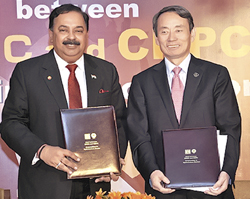Vol. 233 No. 9
OIL AND GAS IN THE CAPITALS
|
DAYSE ABRANTES, CONTRIBUTING EDITOR, LATIN AMERICA
|
From poverty to president of Petrobras
|

|
The appointment, last February, by Brazil’s first woman, President Dilma Rousseff, of Maria das Graças Foster as president and CEO of Brazil’s oil giant and the largest company in Latin America, is a Latin American version of the Horatio Alger story. It is particularly impressive, considering the region’s low upward social mobility.
Growing up in slums. Ms. Graça Foster, as she likes to be called, was born in a favela (Portugese for shantytown or slum), a poor and violent part of Rio de Janeiro, now known as Complexo de Alemào. She started work at the age of eight, collecting wastepaper, bottles and aluminum cans to pay for her school supplies. “I always studied, because I knew I had to. I needed to survive and take care of my mother,” she said in an interview with Valor newspaper.
Despite the hardships, Ms. Graça Foster graduated in chemical engineering from Universidade Federal Fluminense in 1978. She also obtained a masters degree in nuclear engineering from Universidade Federal do Rio de Janeiro in 1979, and an MBA degree in economics from Fundacao Getulio Vargas (FGV) in 1999.
Rising to the top. Ms Graça Foster joined Petrobras as an intern, 32 years ago, studying and working her way up the ranks. She was the second woman at Petrobras to work on an oil platform. She has expressed her dedication to Petrobras, declaring that she would be “ready to die” for the company.
In recent years, Ms. Graça Foster has had numerous influential positions at Petrobras. She acted as a member of the Executive Board, and Gas and Energy officer of the company from Sept. 21, 2007. She has served as President of Petrobras Distribuidora SA since May 2006. In September 2005, she took over as president of Petroquisa, a position she accumulated with that of director for Investor Relations. In 2012, Time magazine included her as one of the 100 most influential people in the world.
Out of Gabrielli’s shadows. The seven-year administration of economist José Sergio Gabrielli as Petrobras president is being revamped completely by Ms. Graça Foster, who also belongs to the ruling Workers Party (PT). Besides replacing five directors appointed by Gabrielli and several senior managers, Graça Foster is undertaking a fundamental review of Gabrielli-era projects.
Punishment for delays. Unlike Gabrielli, Graça Foster does not tolerate delays in orders of goods and services. Examples are the Comperi petrochemical complex in Itaborai, Rio de Janeiro state, and the Abreu de Lima refinery in Pernambuco state. The refinery will finally be ready in November 2014, after a three-year delay and a $3.7-billion overrun above the contracted price $13.362 billion.
Graça Foster is punishing the Atlantico Sul (EAS) shipyard in Ipojuca, Pernambuco state. The oil tanker, João Candido, was scheduled to be incorporated into the Petrobras fleet in 2010, but this only happened recently after a two-year delay. She ordered the Petrobras transport subsidiary, Transpetro, to temporarily suspend 16 of the 20 contracts signed with the shipyard, plus a fine. During Gabrielli’s administration, such delays were not punished.
Graça Foster had harshly criticized several projects undertaken by Gabrielli, but after the intervention of Brazilian President Dilma Rousseff, Graça Foster softened her criticisms and acknowledged that she was partly responsible for several problems, because she was gas and energy director, and major decisions at Petrobras are undertaken by consensus.
Upcoming challenges. Petrobras is working to become one of the top five oil producers in the world. To meet this challenge, Petrobras has to get enough rigs and platforms in place, and also make heavy investment in a recessionary environment. Last June, Petrobras made the world’s largest corporate investment program even bigger, committing the company to $236.5 billion of spending by the end of 2016. That’s nearly $130 million a day for five years, and $11 billion more than its 2011–2015 level. To avoid the “Dutch disease” (a relationship between the increase in natural resource exploitation and a decline in the manufacturing sector), the government has imposed stiff local content regulations, 65% on average, and is working hard to revive local shipyards.
Unlike Gabrielli, who focused mainly on the pre-salt Santos basin, Graça Foster is beginning to implement a major investment program to revert the decline of Campos basin, which is still responsible for about 80% of Brazil’s oil output, even though major fields, such as Marlim, are declining. Petrobras will spend $5.6 billion through 2016 to reverse declining output at the company’s oldest offshore oil fields. Graça Foster faces a crude output target of 6.4 MMboed by 2020. At present, Petrobras produces 2 MMboed.
Close ties with Rousseff. Analysts say that Graça Foster’s technical expertise, and her close relations with President Rousseff, will probably lead to more efficient management. Like the Brazilian leader, Graça Foster has gained a reputation as an efficient technocrat, who is pragmatic and politically strong because of her connections to the president. This bodes well for the future of Petrobras, and the future of the oil and gas industry in Brazil. 

|
Maria das Graças Foster is gaining a reputation as the iron lady of oil.
|
|
|
daysew@frionline.com.br / DAYSE ABRANTES is an independent journalist based in Rio de Janeiro.
|
|
|





